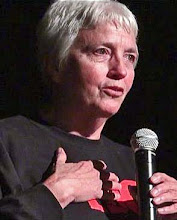Beyond that, I'm not a fan of what this country continues to do to millions of families who are homeless or at-risk of homelessness.
Like Tina. Here's my latest AlterNet post on her holiday-hell. If you're not going to read it--the bottom line is this gallant mother of 7 children is right now scrambling around to move her family into a small house trailer before Jan. 1.
The kicker--she's got to wait for the local housing authority to inspect the 3-BR trailer she's located to move into to make sure it's up to the HUD (US Dept. of Housing and Urban Development) standards. Factor in double holidays at the end of this month and she'll be lucky to make this all happen. If she doesn't, her family will be on the streets in a city without a family shelter.
She didn't procrastinate. Her landlord gave her exactly 30 days notice as required. She jumped right into the search, list of potential housing units in hand. When they weren't panning out, she pleaded for an extension but no go. Speculation is that he's losing the house where her family's lived for this past year. They've gotta go.
I don't know, but I'm thinking Tina and her kids probably aren't enjoying this commercially-motivated Christmas season. And I know they're not the only families suffering from house-lessness, hunger and other maladies during this time of year when most of us are involved in parties, time off from work with pay, shopping and ripping into presents. Scant media attention is given to these unfortunate millions, with a smattering of feel-good stories about Christmas cookies and Barbie dolls being shared with shelter kids.
Here's stuff most people don't know about how millions of our nation's most vulnerable families are housed:
- Subsidized housing, which pays the balance of rent after 30%, using our tax dollars, is only available for about 25% of those who really need it.
- Tenants must pay utilities and deposits, often hundreds of dollars.
- Strict rules govern tenants' behavior--and being kicked out of housing or falling behind on rent can blemish their record to the point of banning them from this program.
- Family/friends who need a place to stay can't bunk with their subsidized housing friend/family member. Guests are limited to 10 days...and pushing that can get everyone tossed to the streets.
- Family/friends with felony records are typically banned from subsidized housing properties.
- With 30 days notice, at the end of the lease period, the owner can tell the tenant to move. No recourse.
Housing authorities oversee subsidized housing. They get federal funds. HUD's budget, now about $45 billion, despite the increased population and soaring poverty and homelessness, has been drastically slashed by the housed Members of Congress over the past 3 decades. That doesn't take into account The Sequester, when HUD's budget took an additional and devastating 10% hit.
Imagine--please--what Tina's family is going through now. No tree or Christmas celebration for the kids. Her truck's axle broke the other day, adding to her fiscal duress. She's scrambling around gathering boxes, shoving stuff in it, and getting her older kids (14 YO) to help. Stress, stress and more stress.
Before you label Tina's family as freeloaders, dependent on government assistance, swallow this bitter pill:
In the spirit of anti-commercial-Christmas, I'd call on a boycott of this carnage called "Christmas" until the most vulnerable families in this country have what they need to (at least) humanly survive. I'm guessing that even Jesus would approve.
According to WRAP, the recent big corporate bailout cost taxpayers over $800 BILLION, far exceeding the entire homelessness/housing assistance budget for 3 decades.





















